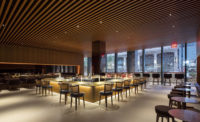The Four Seasons derived its name from the novel theme dreamed up by dining impresario Joseph Baum. In contrast to private enclaves and high-end restaurants where menus had not varied for decades, The Four Seasons would rotate its offerings on a quarterly basis and highlight fresh produce unfamiliar to a generation that had grown up eating canned goods at home. Similarly, the restaurant’s naturalistic indoor plantings, and even the color of waiters’ uniforms, would be changed every three months. At an unprecedented cost of $4.5 million (about $32.7 million today), the Park Avenue showplace dazzled design aficionados, though skeptics found it little more than a gimmicky playpen for the ring-a-ding expense-account crowd.
By the early ‘70s, Baum’s concept had gone stale, and as New York City teetered on the brink of bankruptcy, the faltering Four Seasons was sold. New owners retained the original interior design scheme, but rethought the principal dining spaces at either end of Mies’s barbell-shaped floor plan. Although the symmetrically balanced dining rooms share the same 60-foot-square shape and 20-foot ceiling height, the Pool Room has always felt far larger than the Grill Room (originally called the Bar Room). The Pool Room’s eponymous centerpiece and its spectacular window walls impart an expansive air. The Grill Room, despite its mirror-image version of the Pool Room’s glazing, feels much more enclosed because of its dark wood inner walls and massive square bar (over which looms a Lippold sculpture with vertical gold-metal blades that remind me of modern swords of Damocles).
However, the restaurant’s most celebrated metalwork embellishments are anything but menacing. Because fire codes prohibited fabric hangings on the floor-to-ceiling fenestration, Marie Nichols came up with an ingenious solution inspired by traditional ruched “Viennese” curtains. In a droll transposition, she mimicked those swags with rows of thin aluminum chains suspended between vertical rods. What hadn’t been anticipated was the scintillating way in which the catenaries ripple when air flows up from the floor-level ventilation registers, and the effect remains pure magic.
The perceived hierarchic disparity between the dining rooms was a business liability from the start. Clever restaurateurs had long known that less-attractive sections of their establishments became irresistible once the most famous customers were seated there. Thus, when The Four Seasons began serving lunch in 1974 to boost sagging receipts, the new management put the city’s movers and shakers in the Grill Room, the place that soon gave birth to the term “Power Lunch.”
No Modernist architects had a keener instinct for design in the service of power than Mies and Johnson, siblings under the skin who gravitated to whoever wielded influence and dispensed commissions. Together at The Four Seasons, Mies (architect of spaces imposing in scale and impeccable in proportion) and Johnson (orchestrator of a decorative Gesamtkunstwerk no less impressive) celebrated America’s burgeoning corporate might with a frankness rarely ventured even then, at the apex of our postwar glory.
Mies had little interest in furnishing the rooms he created. In Germany, he relied on his gifted alter ego (and longtime lover), Lilly Reich, who handled what he and his male Bauhaus colleagues disdained as women’s work. After Mies resettled in the U.S. in 1938, he caddishly dumped Reich and shipped her back to Germany, where she died soon after the war. In 1930, though, Reich had designed Johnson’s Manhattan apartment. For Johnson’s own later work, he appropriated her formula of sparingly arranged Mies furniture set off by large expanses of rich materials deployed with disarming simplicity, as exemplified by the Grill Room’s sumptuous book-matched French walnut paneling. Johnson knew how to channel the echt spirit of the émigré master and his exiled handmaiden so well that one wag dubbed their American doppelgänger the “Second Reich.”
Paul Rudolph warned the relative novice Johnson not to collaborate with the living legend Mies on the Seagram job because he’d “just be swallowed up.” In fact, quite the opposite occurred. Johnson imbued The Four Seasons with a sensuousness reminiscent of Mies’s luxurious Barcelona Pavilion and Tugendhat house, and infused it with the juicy quality that drained out of Mies’s work after he moved to America.
It took quite some time for the Seagram Building’s father/daughter patrons — Canadian liquor mogul Samuel Bronfman and architect Phyllis Lambert — to decide whether the ground-floor spaces behind the office tower’s lobby should be used for a car showroom or an art gallery. They settled on a restaurant, a useful showcase for Seagram beverages. When the Bronfmans sold their company (along with its bronze-clad New York headquarters) in 2000, they retained The Four Seasons but sold a minority interest to its current yin-yang management duo: the introspective Alex von Bidder and the ebullient Julian Niccolini, whose diametric temperaments belie their identical perfectionism.
Lambert recently selected Belmont Freeman to renovate the restaurant, which is clearly showing its age. The task demands the same respect, restraint, and affection displayed by Hugh Hardy in his pitch-perfect 1999 refurbishment of Radio City Music Hall. I’m convinced that my all-time favorite restaurant has again found the right talent, and that this embodiment of the New York big time will lure an aspiring generation eager to inherit the banquettes of the Grill Room’s aging titans.




